Online course platforms are definitely among the fast-growing web resources. That’s why, today we’ll focus on two of the most popular platforms — Udemy and Lynda (LinkedIn Learning).
Both platforms offer quick & easy access to multiple educational sources, which make them well-known among learners across the globe.
Udemy and Lynda provide an extensive course base to enhance knowledge of every discipline. Besides, their flexible pricing policy makes the lessons generally available.
Both platforms are easy to use: together with the desktop version, they offer a mobile application to allow users to learn on the go.
In this review, we’ll find out the main features and differences between the platforms. I’m sure that this information will help you to pick up the most appropriate one for taking a course.
Today, we’ll consider:
– the number and type of courses the platforms offer, their quality, and duration;
– the qualifications required to become a course seller;
– the difference in pricing and subscription details.
Before moving on to the review, I offer you to check out similar articles:
Lynda comparisons:
Lynda description:
Comparison
Usability
Udemy
Udemy’s interface is simple to ensure an easy user interaction with the system. On the main page, you can find all lessons with their subcategories.
The platform provides users with a handy drop-down menu to search and select courses. All lessons have previews, requirements, and reviews for easier selection.
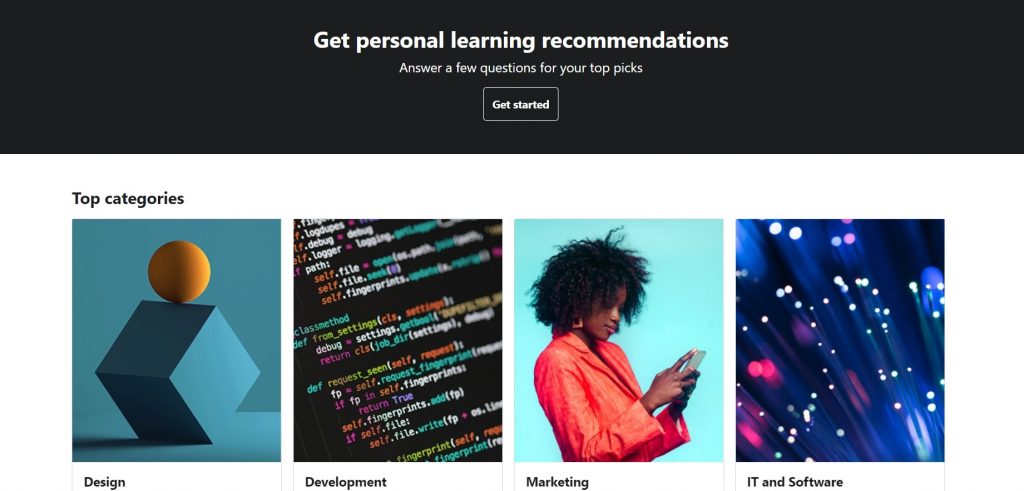
Udemy’s account contains information about the courses purchased, learning progress, and so on. If you can’t make a final decision about what course to choose, you can just add them to a wishlist. It’ll be shown in your account and you can always return to it.
The platform’s video player is handy and allows you to:
- change the speed of videos;
- turn on/turn off closed captions;
- modify video resolution and volume;
- rewind video;
- turn on/turn off subtitles in other languages or use 100% transcript in auto-scroll mode.
Lynda
Currently, the platform is a part of LinkedIn Learning. Thus, choosing a course or subscription on Lynda, you’ll be redirected there (don’t get confused!). So using Lynda is impossible without creating a LinkedIn account or signing into your current one.
After integration, Lynda’s data was transferred automatically, including:
- accounts history and settings;
- exercise files;
- bookmarks;
- video transcripts, etc.
Besides, users got the opportunity to receive individual lessons’ recommendations, social curation, etc.
When you first visit the Lynda study section, you’ll have to fill in a couple of brief surveys. It helps the system figure out what topics and lessons are meeting your interests.
Another way to find the courses is simply browsing.
On the homepage, users can explore the top courses and preview them.
Also, users are provided with a free trial option that allows accessing the courses for a month.
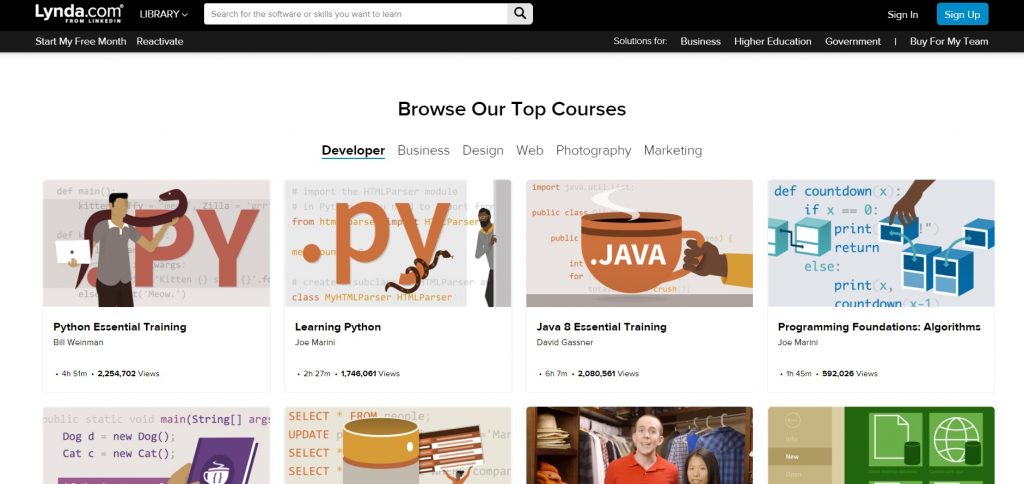
Also, each course contains all necessary info: description, number of lectures, and so on.
Lynda incorporates an in-built messenger tool that allows users to communicate with each other sharing online course feedback.
Besides, the standard LinkedIn feature of checking who has visited your profile for the last 90 days is also there in Lynda.
Courses
Udemy
The platform offers more than 42000 courses on different topics.
When users check up the lessons, it’s possible to examine:
- their description;
- lessons duration and their number;
- if they imply certificate or not;
- a list of similar courses with their short descriptions.
But the most popular ones are dedicated to:
- entrepreneurship (business strategies, freelance, startups, etc.);
- various genres of art;
- healthy lifestyle (fitness, diets, etc.);
- music (musical instruments, vocals, musical production, etc.);
- academics (humanities, mathematics, engineering, etc.);
- development (programming languages, web development, development tools, etc.);
- finance (cryptocurrencies, investing and trading, taxes, etc.);
- office software (Microsoft, Apple, Oracle, etc.);
- personal growth (esotericism, creativity, education, etc.);
- marketing (affiliate marketing, search engine optimization, public relations, etc.);
- photography and video (video design, commercial photography, photography tools, etc.);
- IT and software (networking and security, IT certifications, operating systems, etc.).
The platform is multilingual, so users can study courses in more than 80 languages.
Courses consist of video lessons, which duration can vary from 2 (most of the demonstration videos) to 10 minutes. That’s why, if you decide to study a three-hour course, it may be divided into many short videos.
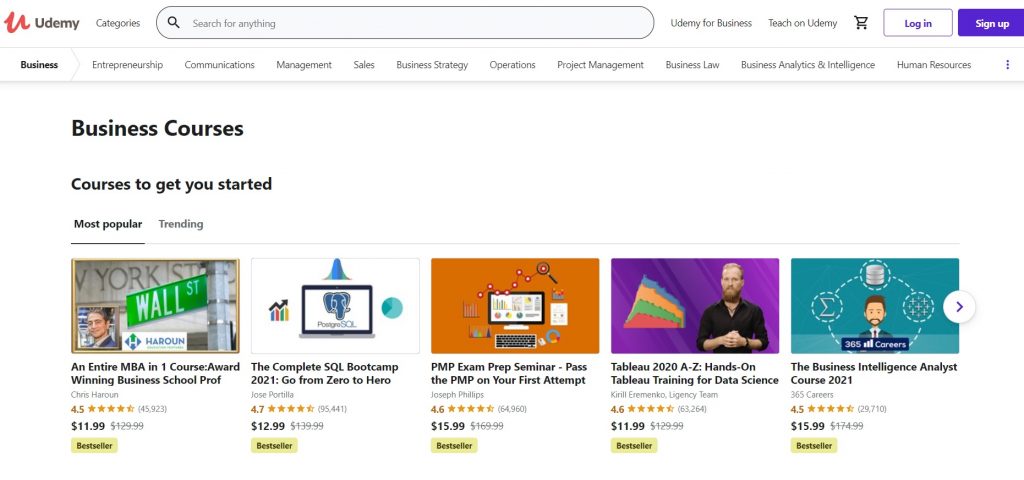
The video lessons are presented in two ways:
- tutorials;
- lectures.
The platform’s layouts help to structure courses. By breaking down the lessons into sections and using short videos, instructors present the material in a logical way. It enables users to:
- check the volume of lessons;
- make a pause (break can’t be more than 10 minutes);
- go over the material one more time to refresh knowledge;
- save time by skipping certain parts that users already know.
Also, the platform offers certificates of completion.
When users purchase courses, they’re free to complete them anytime (there is no timeframe). Plus, they get lifetime access to the course materials.
It corresponds to the main principle of the platform: to provide an unlimited learning possibility in a user-friendly way. It’s worth noting that Udemy has a mobile application: it works on Android as well as on iOS devices.
The platform offers a service called Udemy for Business. With its help, different organizations or businesses can pay for their employees’ courses.
Among the most popular topics are digital technologies, business management, art.
It’s also possible to personalize lessons and courses. This option allows employers to customize the range of employees’ skills. The rate of course completion and results can be tracked.
Lynda
This platform offers a fewer number of courses: at about 12000. However, they all are of the same high quality:
- 3D modeling and animation (textures, game design, creation of visual effects, etc.);
- audio and music (live performances, how to start music business, etc.);
- business (productivity, data analyses, marketing using social networks, etc.). Additionally, this course has 2 guides about how to become a manager and how to start a business;
- computer-aided design (building information modeling, CNS+CAM, how to create prototypes, etc.);
- design (design of websites, logos, work with colors, etc.);
- development (design of mobile and desktop applications, game design, usage of databases, etc.);
- online learning (learning management systems, K 12 education, educational systems, etc.);
- internet technologies (cloud computing, network administration, geographical information systems, etc.);
- marketing (search engine optimization, pay-per-click marketing, analytics, etc.);
- photography (lighting, compositing, high dynamic range photography, etc.);
- video (film directing, visual effects, animation, etc.);
- web (content management systems, user experience design, etc.).
This platform doesn’t offer the same variety of languages as Udemy does. Many courses support the English language only. Among the other available languages, there are German, Spanish, French, and Japanese.
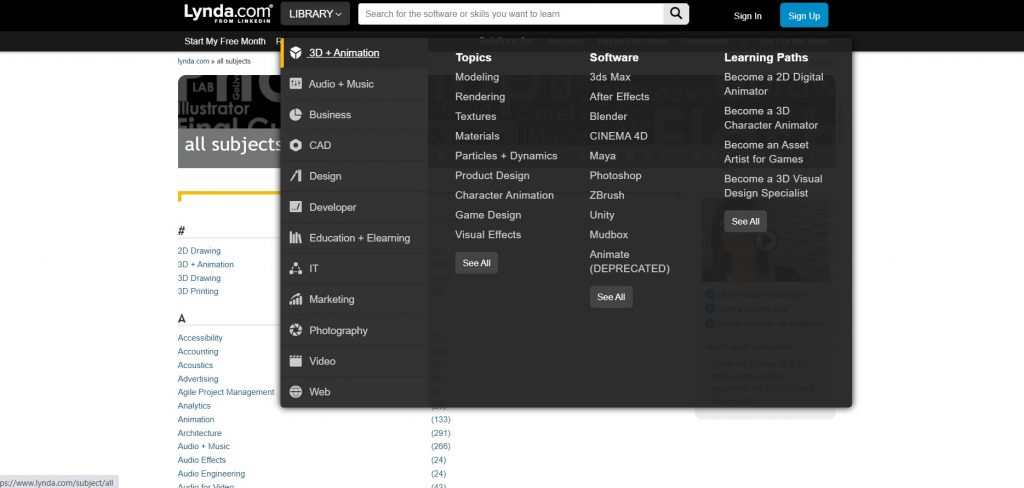
Lynda doesn’t support the same length of video lessons as its competitor does.
After completing most courses, you’ll receive a certificate.
With the subscription to the platform, users get access to all the lessons. The number of courses is increasing systematically: you can see new ones almost every week.
Also, Lynda has an option that Udemy doesn’t provide. It’s called Learning Paths.
It’s a certain number of courses, which are united by a common topic. They’re called “umbrella courses”. For example, if you’re interested in search engine optimization, you’re allowed to choose the “Become the SEO expert” learning path. There you can find all necessary info about keyword use, how to build links, local and global SEO, etc. Video lessons don’t have the same duration and cover various aspects of the same large topic. Besides, the lessons can be presented by different instructors.
Some courses contain a unique set of video lessons. Other paths include groups of already existing lessons. They’re put together only for creating a certain learning path.
Such courses are much longer to study. However, it’s an alternative for the individual ones: when you study the path, it’s almost identical to studying a subject for your college credits.
Lynda’s learning paths are multiple and presented in all main topics.
Instructors
Udemy
The platform doesn’t have strict requirements for the level of specialization of instructors. Among Udemy’s instructors may be the people with specialized skills, who want to share them with the platform’s visitors.
The level of knowledge of instructors can vary from intermediate to academic qualifications. The instructor’s level of income depends directly on the quality of the course material and the number of subscribers.
Lynda
The situation with instructors is different here. First, they have to send an application. After that, they’re selected based on their:
- quality of education;
- professional achievements;
- work experience, and more.
The system of getting paid as an instructor isn’t well understood. It looks like they don’t get a % from course purchases but a one-time payment for the course completion. All information is presented in a casual and simple way. However, it is always valid and high-quality.
It should be said that among the instructors there are popular experts that also increase the authority of the resource. For example, you can find the courses by Guy Kawasaki (marketing specialist and famous venture capitalist) or Ben Long (popular writer, photographer, and teacher).
Price
Udemy
Udemy has a wide pricing range. However, the minimum price starts at $10.
Except for purchasing the specific course, the platform also allows the following ways of getting them:
- People who create and sell lessons can provide their audience with materials. Instructors can choose and set prices they consider reasonable. However, when they start working on the platform, they’re provided with guidelines and tips. With their help, instructors can choose a price depending on the type of content and its duration
- Another way is to create a Business account. By purchasing it, you receive access to more than 4,000 different courses. But there is a nuance: most of the content of these courses is connected with technical topics, development of professional skills, and a healthy lifestyle.
As it was mentioned above, this platform offers a Business plan (Udemy for business) as well. This plan provides 2 options:
- Team. It costs $360 for 1 person annually. It’s an option for groups of 5-20 people. Also, the platform offers a trial period for this plan that lasts 2 weeks.
- Enterprise. It’s an advanced option that implies an individual approach, so this plan offers custom pricing. The cost depends on the company’s needs and its size.
By purchasing the Business plan, managers can assign certain courses to the specific employees, track how quickly and successfully they pass the lessons.
Lynda
This platform has the same flexibility of prices. Costs have changed after Lynda’s takeover by LinkedIn. Currently, there are 2 subscription options:
- Monthly. It costs $29.15.
- Annually. In this case, users pay $19.42 per month and can save about 33%.
Pros and Cons
Udemy
Pros:
- a large base of courses that cover multiple topics;
- lifetime access after buying a course;
- customized business options;
- user-friendly desktop and mobile applications;
- regularly refreshing discount system;
- multilingual support (over ninety languages);
- ability to choose courses of different levels from intermediate to advanced.
Cons:
- the platform isn’t accredited;
- since there are no strict requirements for instructors, there is no guarantee all lessons are of high quality;
- some lessons are really pricey.
Lynda
Pros:
- users can change the speed of video lessons;
- the quality of most lessons is guaranteed;
- you can find comments in every tutorial video;
- lessons are focused on gaining practical knowledge and using it in reality;
- you may use video transcripts;
- users can ask other members of the platform for help or advice;
- all content is made by professional instructors and published only after approval;
- the system supports five languages;
- on finishing the courses, you’re allowed to get a certificate. Then, they can help attract the employers’ attention;
- it’s possible to subscribe employees to certain courses and monitor their progress.
Cons:
- the platform doesn’t have its own community;
- mobile application is not well-optimized;
- a short length of video lessons.
Support
Udemy
The platform offers an extensive knowledge base where you can find the answer to almost every question regarding the site’s functionality. It’s divided into 2 sections:
- for students;
- for instructors.
Each section has a list of the most popular topics. There, you can find a contact email and send your question to the support team directly. Also, it’s possible to follow the platform’s Instagram, Facebook, and Twitter accounts.
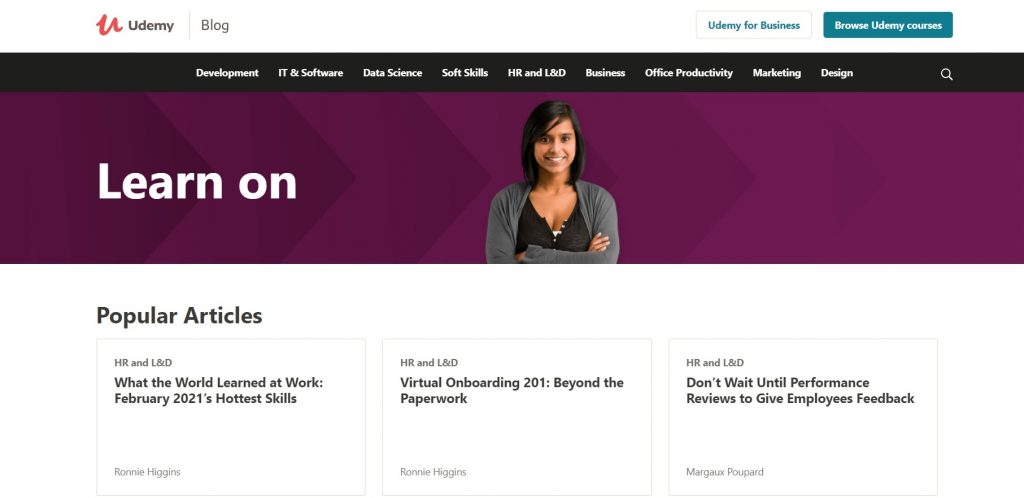
Udemy has its own community that you can join as well to share your experience, ask questions, etc. Additionally, it’s impossible to contact Udemy’s experts by phone or through live chat.
Lynda
If users have problems using the platform, they are welcome to add support tickets. You can find this option on the support page. There, you can also access the most popular topics and recommended articles about using the platform, pricing policy, certificates, & more.
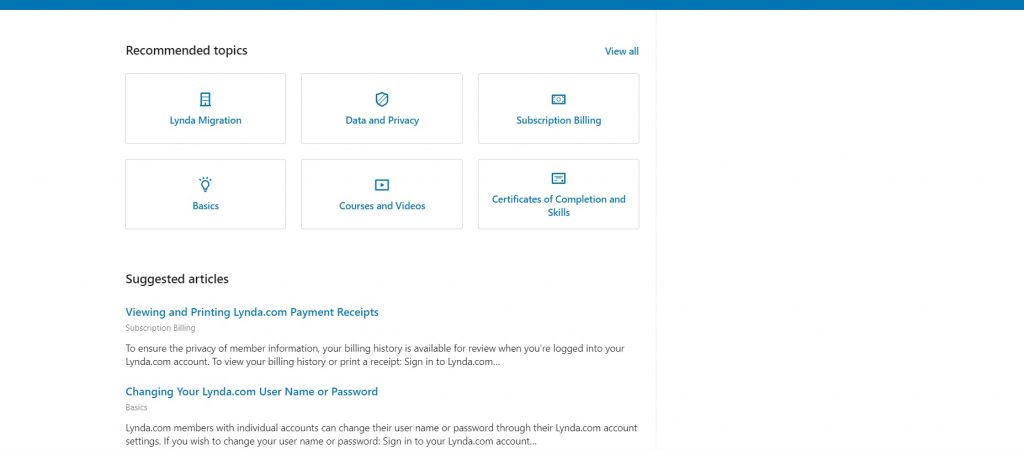
It’s also possible to follow Lynda on Twitter and Facebook. Unlike Udemy’s case, you can’t reach out to the support team by phone or using a live chat.
FAQ
Can I cancel the purchased course on Udemy and get the money back?
Yes, it’s possible. You can refund your money within a month. To do it, you need to follow the simple steps listed on the official website.
Is Udemy an accredited platform?
Even though you get a certificate of completion, the platform isn’t accredited.
Should I pay some fee to become a teacher on Udemy?
No. Plus, if you’re an instructor, you get paid according to the income share system.
Is it possible to download lessons?
Yes, many instructors upload their courses together with the additional materials that can be downloaded (PDF files, presentations, source codes, etc.).
Is the functionality of the mobile version of Lynda the same as the desktop version?
No, there are some features, which are not available in mobile applications: files with tasks, video transcripts, bookmarks, etc.
Is it possible to download materials offline on Lynda?
Yes, it’s possible. To do it, you have to get a desktop application and follow a simple step-by-step guide.
Is the Lynda recognized among employers?
No. After completing the courses, users can get certificates of completion, but it’s not the same as the certificate of competence.
What types of payments does Lynda support?
Lynda supports MasterCard and Visa. Also, you can use PayPal, Discover, and American Express for transactions.
Conclusion
After a careful Udemy vs Lynda review, I can say that both platforms offer a large course base enough to cover the needs of the most enthusiastic learners.
Besides, their pricing policy differs: Udemy offers lifetime access to the courses and reasonable costs. At the same time, Lynda provides users with the ability to access all lessons after a monthly subscription. So if you’re interested in one specific topic, it would be better to use Udemy. However, If you’re after acquiring a deeper understanding of the topic and ready to spend more time and money on this, Lynda is an option for you. In this case, I’d recommend choosing a Learning Path to study a set of video lessons related to your topic.
While Udemy has a significantly larger number of supported languages, it can’t boast of the high professionalism of all instructors, unlike Lynda.
